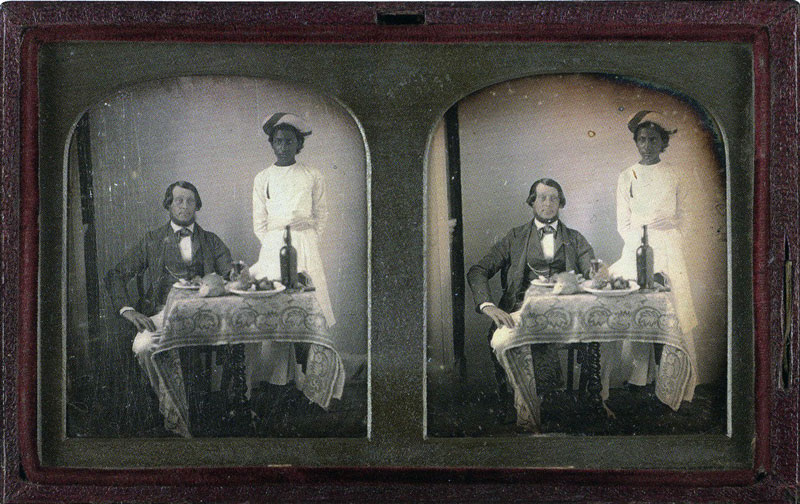|
Picture Paradise
intro page | main essay | photo processes | the plates | background | bibliography
 |
James W Newland, Great Britain, Portrait of a European man with his Indian servant c. 1853 India,
stereo daguerreotype 7.2 x 5.9 cm (each) Jane and Howard Ricketts, London, UK |
The march of process: a snapshot of photographic technology
Two photographic processes made their debut in Europe in January 1839.
The daguerreotype, developed by the French painter Louis-Jacques Mande Daguerre, was the most impressive, capturing mirror-sharp images on small polished metal plates. The first daguerreotypes were exquisitely detailed views of empty streets, buildings and objects. Anything that moved became a ghostly blur. By 1841 reductions in the time needed for exposure meant portraits could be made.
The rival process, photogenic drawing, developed by the British scientist and amateur artist William Henry Fox Talbot, produced soft negative images on sheets of high-quality writing paper, now referred to as salt prints. Both processes produced a single and unique image.
In 1841, Talbot patented an improved process, the calotype, through which many positive paper prints could be produced from a master paper negative, making it possible for photographs to be published in large editions. With refinements, the calotype in the 1850s was a robust and useful process that produced prints with strong details and rich tones.
From 1851 both processes were superseded by the wet collodion glass-negative process. This provided the detail of the daguerreotype with the reproducibility of the calotype. A disadvantage of the process was that the glass plates had to be coated, exposed and then developed and fixed on the spot, making it difficult for outdoor and expeditionary photography.
In the 1880s, the dry-plate process eliminated the need for cumbersome equipment to coat and develop the plates at the time of exposure. Dry-plate photography and the new Kodak amateur cameras in the 1890s opened up photography to greater numbers of amateurs.
By the First World War flexible lightweight gelatine film negatives were displacing glass plates and cameras became smaller and more portable. In the 1920s the 35mm camera began to replace older, larger formats.
The first successful colour processes appeared in 1908 and some work in autochrome was done in the Asia-Pacific region before 1914 but little was published before the 1920s.
more on Picture Paradise
intro page | main essay | photo processes | the plates | background | bibliography
|
